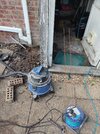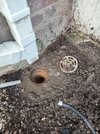Hello All
For years now, whenever it rains we've had some flooding appear. Its taken me a long time to get around to looking at it because the internal area is really more like garage quality. Its a passage with a rough concrete floor and brick sides (unclad). There is a shared sewer about 6ft underneath it which I'm guessing the downpipe feeds. I found out so far that the downpipe drain is completely blocked and when the water backs up it seeps through a hole in the crappy wooden doorway structure. I'll look into sorting the hole but for now would like to unblock (or should I re-route?) the drain.
Its a clay swept bend presumably 4 inches. They would have been put in in 1970. There was a big problem with ivy in the past with roots going down the drain. I found it was filled to the top with soil. I've dug what I could out but need smaller hands and the wife wasn't going anywhere near it 8-(. A 1M single rod went in about 2/3 but then I couldn't ram it any further.
So one question I have is how likely/unlikely would a drain cleaning hose attachment to my power washer be to clear it? And if it doesn't, could I fit a soakaway nearby re-routing the water? Another question is would a clay trap typically have been fitted after the swept bend or would a trap be integral to the drain? That would make a drain cleaner even harder to remove the blockage? Thanks a lot for reading and for any tips.
For years now, whenever it rains we've had some flooding appear. Its taken me a long time to get around to looking at it because the internal area is really more like garage quality. Its a passage with a rough concrete floor and brick sides (unclad). There is a shared sewer about 6ft underneath it which I'm guessing the downpipe feeds. I found out so far that the downpipe drain is completely blocked and when the water backs up it seeps through a hole in the crappy wooden doorway structure. I'll look into sorting the hole but for now would like to unblock (or should I re-route?) the drain.
Its a clay swept bend presumably 4 inches. They would have been put in in 1970. There was a big problem with ivy in the past with roots going down the drain. I found it was filled to the top with soil. I've dug what I could out but need smaller hands and the wife wasn't going anywhere near it 8-(. A 1M single rod went in about 2/3 but then I couldn't ram it any further.
So one question I have is how likely/unlikely would a drain cleaning hose attachment to my power washer be to clear it? And if it doesn't, could I fit a soakaway nearby re-routing the water? Another question is would a clay trap typically have been fitted after the swept bend or would a trap be integral to the drain? That would make a drain cleaner even harder to remove the blockage? Thanks a lot for reading and for any tips.



